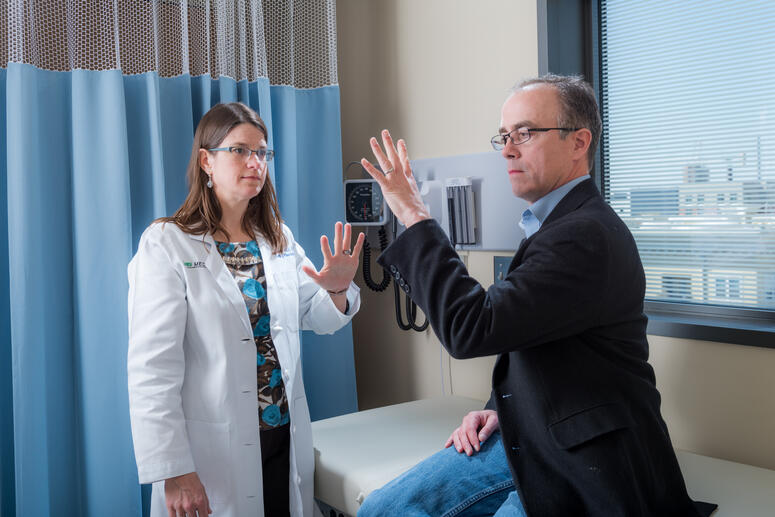
Managing “off” time, when medication wears off and Parkinson’s symptoms return, can sometimes be a challenge.
Typically, “off” time is minimized by modifying Parkinson’s medications, which work in different ways. A doctor might recommend a change to the dosage or timing of levodopa, which turns into dopamine, the brain chemical that is lost in Parkinson’s. Levodopa, often combined with carbidopa, is generally considered the most effective medication for the disease.
Another medication might be added, like those that work to boost the effect of levodopa by making it last longer or helping more get into the brain. Other on-demand drugs might be taken only as needed (in addition to other regularly scheduled Parkinson’s medications) for sudden, unexpected “off” time.
Learn more about understanding and managing “off” time.
Advances in “Off” Time Medications
Since the founding of The Michael J. Fox Foundation, there has been a significant increase in the number of available medications for Parkinson’s disease. Today, the therapeutic pipeline for Parkinson’s is the strongest in history. Since 2024, the U.S. Food and Drug Administration (FDA) has approved three new drugs:
- Crexont: This long-acting pill aims to improve motor symptoms like tremor, slowness and stiffness for a longer period with fewer doses. It combines an extended-release formulation of levodopa/carbidopa with immediate-release levodopa/carbidopa to reduce “off” time, when symptoms are less controlled.
- Vyalev: This treatment aims to increase “on” time (when symptoms are well controlled) through a steady source of levodopa/carbidopa. The medication is delivered continuously under the skin through a pump, like the one used to deliver insulin for diabetes. The steady flow of medicine may smooth out symptoms for people who still experience ups and downs with pills.
- Onapgo: This therapy is also a continuous infusion of medication using a pump. It gives a constant supply of apomorphine, a medication (called a dopamine agonist) that looks and acts like dopamine, the brain chemical that decreases in Parkinson’s. This continuous dosing aims to provide more consistent control of symptoms.
Surgical Treatments for “Off” Time
Surgical interventions can be used to ease symptoms for some people when medications and other strategies aren't enough. These include deep brain stimulation (DBS) and MRI-guided focused ultrasound (FUS). Neither is a cure for Parkinson’s, nor do they generally provide direct relief for non-motor symptoms, walking difficulties, falls or imbalance. Still, both may lessen tremor, slowness, extra movements (dyskinesia) or muscle spasms (dystonia), and decrease the amount of medication needed to control symptoms.
- Deep Brain Stimulation: This procedure uses implanted electrodes, or wires, to stimulate areas of the brain that control movement. DBS is thought to interrupt the irregular signals that cause tremor and other movement symptoms. This yields a more even, consistent effect, resulting in reduced “off” time and dyskinesia. In early 2025, the FDA approved the first “adaptive,” or self-adjusting DBS, which automatically tailors stimulation, in real time, to address symptoms. The Michael J. Fox Foundation provided funding for the earliest stages of research into this new technology.
- Focused Ultrasound: This surgical treatment uses concentrated sound waves to target and destroy tiny, specific brain areas that contribute to movement, or motor, symptoms and complications, like dyskinesia and “off time.” With FUS, there are no incisions or placement of hardware, like brain wires or a battery. Benefits typically take effect immediately, but it is permanent and irreversible. Since 2018, FUS was FDA approved to treat one side of the brain (“unilateral”) and therefore ease symptoms on one side of the body. In 2025, the FDA approved both-sided, or “bilateral,” FUS. This treatment is delivered one side at a time, separated at least six months apart, and aims to ease motor symptoms and complications on both sides of the body. The Michael J. Fox Foundation funded an early study of FUS for dyskinesia.
What’s the difference between DBS and FUS?
Deep brain stimulation and focused ultrasound differ in technique, benefits and side effects. Learn more about both procedures from Rachel Dolhun, MD, DipABLM, a movement disorder specialist, lifestyle medicine physician and principal medical advisor at MJFF.
“Off” Time Medications in Development
Other promising treatments that address “off” time are in advanced stages of clinical testing, potentially giving people with Parkinson’s more options in the future. They include:
- Tavapadon: This once-a-day pill demonstrated significant improvement in easing motor symptoms in Phase III clinical trials when taken alone (without levodopa) in newly diagnosed patients with less severe symptoms. Additionally, it increased total daily “on” time by about an hour when added to levodopa for patients with more advanced Parkinson’s, without increasing side effects. The manufacturer submitted a New Drug Application to the FDA in September 2025, with a decision on approval expected in the first half of 2026.
- ND0612: This is a liquid form of levodopa/carbidopa infused under the skin 24 hours a day, providing consistent medication levels for regular motor symptom relief. In a Phase III clinical trial, people with Parkinson’s taking ND0612 had nearly one and three-quarters hours more "on" time per day, without symptoms like significant tremor, slowness, stiffness or dyskinesia (involuntary movement), when compared to oral levodopa/carbidopa. The Michael J. Fox Foundation funded early studies of this therapy, which is currently under FDA review with potential approval by late 2025.
This resource was brought to you with support from Amneal Pharmaceuticals and Merz Therapeutics. Partner support allows us to furnish high-quality educational content to the Parkinson’s community while allocating donor dollars to high-impact research. The Michael J. Fox Foundation is solely responsible for the content on this page.
All medical information is for general information purposes only. The Michael J. Fox Foundation has a policy of refraining from advocating or endorsing any drug therapy, course of treatment, specific company or institution. Care and treatment decisions should be made in consultation with a physician or qualified medical professional.